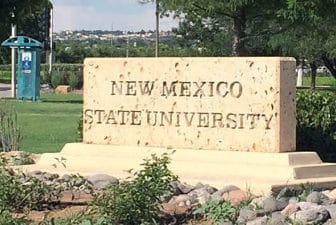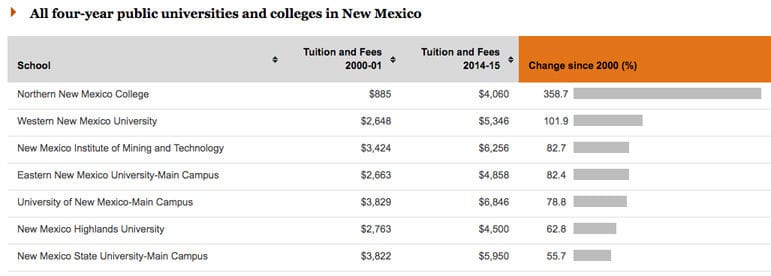When the New Mexico State University Board of Regents rejected a proposed 5 percent tuition increase in April, Student Regent Amanda López Askin called it “a very deliberate breaking of a cycle.”

Heath Haussamen / NMPolitics.net
The New Mexico State University sign at the corner of Union Avenue and Sam Steele Way in Las Cruces.
It’s true that NMSU’s tuition and fees increased 55.7 percent between the 2000-2001 and 2014-2015 school years, according to a new analysis. But the cost of attending NMSU hasn’t spiked as much as it has at other public colleges in New Mexico and some surrounding states.
That said, NMSU remains the third most expensive public college to attend in New Mexico behind the University of New Mexico in Albuquerque and the New Mexico Institute of Mining and Technology in Socorro.
The new analysis by the news organization ProPublica examined tuition and fees at public colleges across America and compared that with the nation’s median household income. Nationally, tuition and fees at public colleges increased from $4,454 a year during the 2000-2001 school year to $8,017 during the 2014-2015 school year — an average increase of 80 percent. It should be noted that ProPublica adjusted the 2000-2001 school-year costs to 2014 dollars to account for inflation using U.S. Bureau of Labor statistics.
While public college tuition and fee costs spiked, the national median household income dropped 7 percent between 2000 and 2014, from $57,724 to $53,657.
In New Mexico, the average annual cost of public college tuition and fees rose during that time from $2,862 to $5,402 — an increase of 89 percent. Meanwhile, the state’s median household income fell by 3 percent, from $48,242 to $46,686.
At NMSU’s main campus in Las Cruces, tuition and fees rose from $3,822 a year to $5,950. That 55.7 percent increase was lower than every other public university in the state.
The steepest hike in New Mexico was at Northern New Mexico Community College in Española, where tuition and fees rose 358.7 percent, from $885 to $4,060. In terms of percentage, that was the second-highest increase in the United States, though the college is still the cheapest in the state.
Coming in second in New Mexico was Western New Mexico University in Silver City, where tuition and fees rose from $2,648 to $5,346, an increase of 101.9 percent.
At the New Mexico Institute of Mining and Technology in Socorro, tuition and fees increased 82.7 percent, from $3,424 to $6,256. Tuition and fees increased 82.4 percent — from $2,663 to $4,858 — at Eastern New Mexico University’s main campus in Portales.
The University of New Mexico’s main campus saw an increase in tuition and fees of 78.8 percent, from $3,829 to $6,846. UNM is the most expensive public university to attend in the state, with annual tuition and fees that are about $900 higher than NMSU. During the 2000-2001 school year, tuition and fees at UNM and NMSU were roughly equal.
And at New Mexico Highlands University in Las Vegas, tuition and fees increased 62.8 percent, from $2,763 to $4,500, between the 2000-2001 and 2014-2015 school years.

A screen shot showing ProPublica’s analysis of the rise in public college tuition and fees in New Mexico between the 2000-2001 and 2014-2015 school years. Click here to view a larger version of the chart.
NMSU — and most New Mexico public colleges — have done a better job of keeping tuition increases to a minimum compared to colleges in surrounding states. In Arizona, tuition and fees at public colleges increased an average of 202 percent between the 2000-2001 and 2014-2015 school years, from $3,201 to $9,812. In Colorado, tuition and fees increased an average of 116 percent, from $3,899 to $8,414.
And in Texas, the average tuition and fees increased 112 percent, from $3,309 to $7,054. At the University of Texas-El Paso, NMSU’s closest competitor geographically, tuition and fees increased 102.8 percent, from $3,481 to $7,059.
NMSU is working to address a $12.1 million budget shortfall in the current fiscal year that was caused largely by reductions in state funding and decreased student enrollment. The Regents’ decision to not increase tuition earlier this year meant more dramatic budget cuts were necessary. Most other public colleges in New Mexico, including UNM, raised tuition again this year to help cover state funding cuts.
To help balance its budget, NMSU is instead making cuts that include eliminating at least 120 filled and vacant positions. The Board of Regents recently approved reductions in some employee benefits. Chancellor Garrey Carruthers and many other high-ranking university employees have taken pay cuts that are expected to save $190,000 a year.
Other cuts and proposed cuts, including those to employee health services, the equestrian team and the Surveying Engineering program, are part of a requirement that all colleges and administrative divisions reduce their budgets by between 5 and 6.2 percent.
Cutting the surveying academic program isn’t final. The Regents must still decide whether to approve that cut. Carruthers has the authority to impose all other cuts he’s announced.
New Mexico’s public colleges may face additional state funding cuts this year. State government officials are grappling with an estimated $458 million budget shortfall.
You can explore ProPublica’s public college tuition and fee database here.